 |
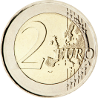 |
C o m m e m o r a t i v e
C o i n s |
||
| Estonia | |||||||
The edge lettering of the Estonian 2‐euro‐commemorative coins is : (Estonia) |
|||||||
| Image | Country | Feature | Ref. | ||||
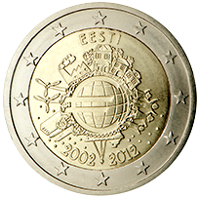
|
 |
Estonia | 10th anniversary of the Euro‐Currency | 20001 |  |
||
Volume : 2,000,000 Date of Issue : 02 Jan. 2012 Designer : Helmut Andexlinger Producer : German mint Staatlichen Münze Berlin in Berlin (without Mintmark) |
|||||||
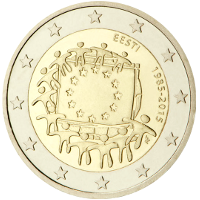
|
 |
Estonia | 30th anniversary of the EU‐Flag | 20001 |  |
Volume : 350,000 Date of Issue : 10 Dec. 2015 Designer : Georgios Stamatopoulos ("ΓΣ") Producer : Lithuanian mint Lietuvos monetų kalykla in Vilnius (without Mintmark) |
|||||
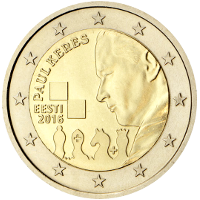
|
 |
Estonia | 100th birthday of chess grandmaster Paul Keres | 20001 |  |
Volume : 500,000 Date of Issue : 07 Jan. 2016 Designer : Riho Luuse Producer : Lithuanian mint Lietuvos monetų kalykla in Vilnius (without Mintmark) |
|||||
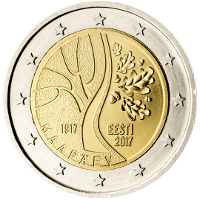
|
 |
Estonia | Estonia's road to independence | 20001 |  |
Volume : 1,500,000 Date of Issue : 26 Jun. 2017 Designer : Jaan Meristo Producer : Lithuanian mint Lietuvos monetų kalykla in Vilnius (without Mintmark) |
|||||
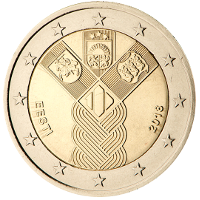
|
 |
Estonia | Establishment of the states of Estonia and Latvia, Re‐establishment of the state of Lithuania Common Issue of the three Baltic States |
20001 |  |
Volume : 500,000 Date of Issue : 31 Jan. 2018 Designer : Justas Petrulis Producer : Lithuanian mint Lietuvos monetų kalykla in Vilnius (without Mintmark) |
|||||
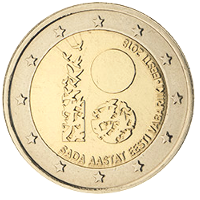
|
 |
Estonia | 100 years Independence | 20001 |  |
Volume : 1,317,800 Date of Issue : 19 Feb. 2018 Designer : Ionel Lehari and Meelis Opmann Producer : Lithuanian mint Lietuvos monetų kalykla in Vilnius (without Mintmark) |
|||||
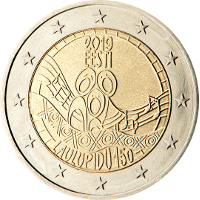
|
 |
Estonia | 150th anniversary of the first Estonian Song Festival | 20001 |  |
Volume : 1,000,000 Date of Issue : 29 May 2019 Designer : Grete Lisette Gulbis Producer : Slovakian mint Mincovňa Kremnica š.p. in Kremnica (without Mintmark) |
|||||
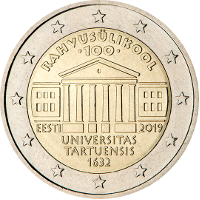
|
 |
Estonia | 100 year anniversary of the founding of the Estonian language University Tartu | 20001 |  |
Volume : 1,000,000 Date of Issue : 19 Nov. 2019 Designer : Indrek Ilves Producer : Lithuanian mint Lietuvos monetų kalykla in Vilnius (without Mintmark) |
|||||

|
 |
Estonia | 200th anniversary of the discovery of the Antarctic | 20001 |  |
Volume : 750,000 Date of Issue : 27 Jan. 2020 Designer : Tiiu Pirsko and Mati Veermets Producer : Lithuanian mint Lietuvos monetų kalykla in Vilnius (without Mintmark) |
|||||

|
 |
Estonia | 100th anniversary of the Treaty of Tartu | 20001 |  |
Volume : 1,000,000 Date of Issue : 01 Feb. 2020 Designer : Ivar Sakk Producer : Lithuanian mint Lietuvos monetų kalykla in Vilnius (without Mintmark) |
|||||
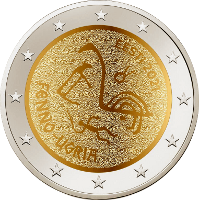
|
 |
Estonia | Finno‐Ugric peoples | 20001 |  |
Volume : 1,000,000 Date of Issue : 16 Jun. 2021 Designer : Al Paldrok and Madis Pöldsaar Producer : Lithuanian mint Lietuvos monetų kalykla in Vilnius (without Mintmark) |
|||||
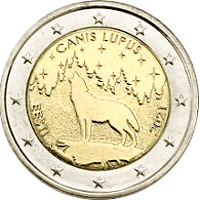
|
 |
Estonia | The Wolf 1st coin of the national symbols of Estonia series |
20001 |  |
Volume : 1,000,000 Date of Issue : 20 Oct. 2021 Designer : Maria Meos Producer : Lithuanian mint Lietuvos monetų kalykla in Vilnius (without Mintmark) |
|||||
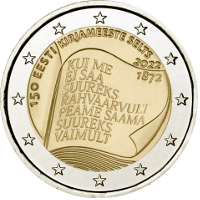
|
 |
Estonia | 150th anniversary of the Society of Estonian Literati | 20001 |  |
Volume : 1,000,000 Date of Issue : 09 Mar. 2022 Designer : Riho Luuse Producer : Finnish mint Suomen Rahapaja OY in Vantaa (without Mintmark) |
|||||
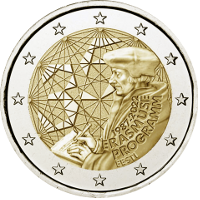
|
 |
Estonia | 35th anniversary of the Erasmus Program | 20001 |  |
Volume : 1,000,000 Date of Issue : 01 Jul. 2022 Designer : Joaquin Jimenez Producer : Lithuanian mint Lietuvos monetų kalykla in Vilnius (without Mintmark) |
|||||
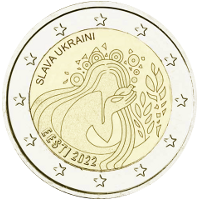
|
 |
Estonia | Slava Ukraini | 20001 |  |
Volume : 2,040,000 Date of Issue : 08 Jul. 2022 Designer : Daria Titova Producer : Finnish mint Suomen Rahapaja OY in Vantaa (without Mintmark) — Coincards : Slovakian mint Mincovňa Kremnica š.p. in Kremnica (without Mintmark) |
|||||
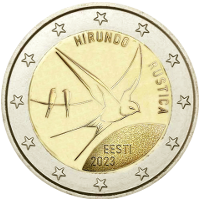
|
 |
Estonia | The Barn Swallow 2nd coin of the national symbols of Estonia series |
20001 |  |
Volume : 1,000,000 Date of Issue : 12 May 2023 Designer : Kaupo Kangro Producer : Finnish mint Suomen Rahapaja OY in Vantaa (without Mintmark) |
|||||
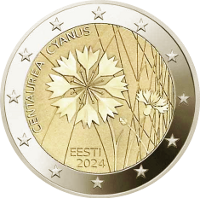
|
 |
Estonia | The Cornflower 3rd coin of the national symbols of Estonia series |
20001 |  |
Volume : 1,000,000 Date of Issue : 21 May 2024 Designer : Kaupo Kangro Producer : Finnish mint Suomen Rahapaja OY in Vantaa (without Mintmark) |
|||||
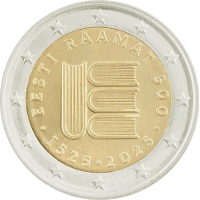
|
 |
Estonia | 500th anniversary of the first printed text in Estonian | 20001 |  |
Volume : 858,500 Date of Issue : 30 Jan. 2025 Designer : Svetlin Balezdrov Producer : Lithuanian mint Lietuvos monetų kalykla in Vilnius (without Mintmark) |
|||||
| References : | |||
| 20001 | Images taken with authorisation by the ECB ‐ Mail dated 20.Feb.2020 © "European Central Bank" |
20002 | Not Applicable |
| 20003 | Images taken temporally from the Internet | 20004 | Not Applicable |
 |



